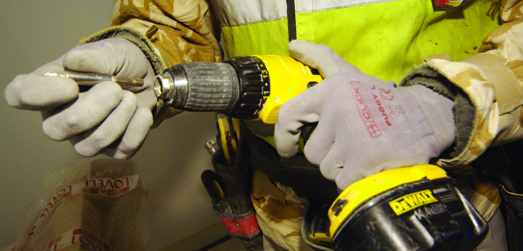Last year, 42 construction workers were killed in accidents at work – mercifully a reduction on previous years and lower than the EU average. But there were also 76,000 reported cases of work-related illness, 31,000 of which were new. This in turn led to the loss of 2.3 million working days at a cost of approximately £1.1 billion to the UK economy. David Cant from Veritas Consulting outlines what are these health issues related to the construction industry?
Asbestosis
Probably the best known of all occupational health risks, asbestosis is caused by inhaling asbestos fibres into the lungs. Long-term exposure to the fibres can cause lung cancers, particularly mesothelioma, that often prove fatal in the long term.
Because of the extensive use of asbestos in construction during the 20th century, asbestosis continues to be a significant killer of construction workers.
Figures from the Health and Safety Executive demonstrate a continued upward trend with more than 450 people dying of the condition each year.
Although it is now illegal to use asbestos in construction, existing structures may still contain the material. Employers have a duty of care to carefully assess sites for the presence of asbestos and to take suitable steps to prevent employee exposure to fibres.
Silicosis
Similar to asbestosis, silicosis is a form of pneumoconiosis caused by the inhalation of silica crystals. The silica dust causes inflammation and scarring of the lungs, with advanced cases leading to respiratory difficulty, heart disease and increased risk of contracting tuberculosis. Complications with these conditions can lead to death.
Employees working with pneumatic drills or using sandblasting equipment are particularly susceptible to inhaling silica crystals. Employers must therefore ensure that workers are given the appropriate personal protective equipment (PPE) to reduce the risk of inhaling silica crystals and developing silicosis.
Similar illnesses can be caused by inhaling any kind of dust on-site, including that from cement and brick. The importance of risk assessments for all roles on-site to reduce potential health problems cannot be understated.
Vibration white finger (VWF)
Also known as hand-arm vibration syndrome (HAVS), this condition is caused by prolonged use of vibrating machinery such as pneumatic drills. Over time, the vibrations cause damage to blood vessels, nerves, muscles and joints in the hands and arms.
Initially workers affected by VWF will experience a tingling numbness in the fingers, which over time will result in fingers going white when exposed to cold; as circulation returns, the fingers will throb painfully. If the worker continues to be exposed to vibrations they may eventually experience a loss of manual dexterity as their nerves and muscles are damaged further – in extreme cases, people have been known to lose fingers due to VWF syndrome.
Employers must assess equipment used on-site for vibration amplitude and calculate safe working limits for each.
Diesel engine exhaust emission related cancers
The use of generators across construction sites increases exposure to diesel engine exhaust emissions (DEEE), and these emissions contain various particulates, including Polycyclic Aromatic Hydrocarbons (PAHs), which are known to be carcinogenic.
Diesel engines that produce blue or black smoke (a visual indication of the presence of particulates) could be particularly dangerous to workers health over longer timeframes. Where employees work in enclosed spaces in which DEEE collect, the danger of acquiring health complications increases.
Again, employers need to assess the danger caused
by emissions, provide adequate ventilation to minimise DEEE inhalation and perform routine maintenance on engines to further reduce particulate emission.
Skin cancers
Because most construction work takes place outdoors, employees are exposed to the elements year round. Spending long periods in the sun without proper protection increases the risk of developing melanoma (skin cancer). As with many other forms of cancer, melanoma can result in death if left untreated.
Employers will need to raise awareness among workers of the potential dangers of exposing themselves to the sun while working outdoors. After a risk assessment, some employers may find that workers at high risk of sunburn or prolonged exposure to the sun require additional PPE to keep them safe.
Respiratory illnesses
Construction projects taking place in damp or mouldy conditions could place workers at risk of developing respiratory illnesses including pneumonia, bronchitis and infections related to mould spores.
A risk assessment should reveal the presence of damp and mould, whereupon employers can enact measures to protect workers. Face masks and waterproof clothing will help mitigate problems, as will training staff in how to work safely in such an environment.
So, over to you. What other risks to health have your own risk assessments identified? How did you deal with them?
David Cant
Veritas Consulting
www.veritasconsulting.co.uk


